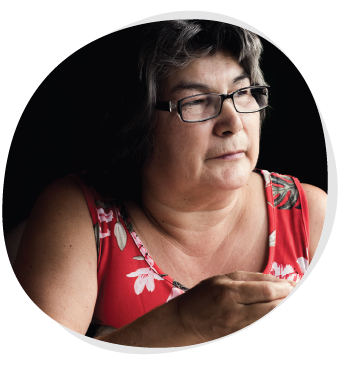« I want to keep traditional skills and knowledge going; and I want to keep our language. That’s what motivates me! I do it for the kids. »
After the passing away of her mother, Grace stayed in a foster family until she was returned to her uncles. This is how, at only 2 years old, Grace met the woman who would eventually become her rock, her reference, her source of inspiration. Kokoum Lina took little Grace under her wing and taught her everything she knew, including doing beadwork, tanning moose hides and making a tikinagan. A widow for many years, Kokoum Lina learned to be resourceful, and taught Grace everything about life in the forest. She took care of the girl until she had to leave her community to attend residential school. During her school years, Grace spent her free time with Kokoum Lina to continue her true education.
« She didn’t teach me like ‘do this, do that’, but I would observe. A lot of observation without doing anything. Just observing. Sometimes, if she needed help, I would help but most of the time was through observation and that’s how you were taught: through observation and listening. »
Grace’s approach profoundly reflects the education she received from Kokoum Lina. She teaches in the open air or in a tent. When the school from her community contacted her to share her knowledge with children, she accepted to take on the challenge provided that she could take them into the forest, where their culture comes to life. She started to organize educational excursions and show them how to tan hides in a big canvas tent near her house. Her objective was to teach the children things they just cannot learn in school, i.e., the Anishinaabe way: through observation, listening and touch. This is how she learned how to practise her culture. Grace believes that today’s children should have the same opportunities. The survival of Anishinaabe culture depends on it.
This is how Grace came up with the original idea for the educational tool WIKWEMOT (bark basket), developed by Minwashin. WIKWEMOT is a resource for collecting, preserving and transmitting elements of Anicinabe culture to young people, through educational activities to be carried out in the classroom or at home, through a digital universe accessible to all. The educational basket also includes an original application that brings together traditional knowledge about kacabagonegabwec – the moose – and is accessible on cell phones and tablets to reach young people and families. Grace travels to schools throughout the region to share these tools and pass on her knowledge of the moose.
Grace is increasingly invited to conduct workshops in other communities. She watches the participants at work and offers help when requested; however, much is left to experimentation. The participants are encouraged to draw on their own resources to find solutions. The nature of the workshops depends on the groups and their areas of interest. Grace has the competence to teach many skills as diverse as making moccasins, doing beadwork and butchering a beaver. However, the foundations of her teaching remain the same: observation and hands-on experience. Her projects for the coming years? Devoting more time to teaching, and travelling all over the region to meet other Anishinaabe communities.
See more of Grace’s work on Gracefull Muks and Anishnabe Arts and Crafts.
Grace is truly an innovative cultural ambassador who thinks outside the box, she is a great source of inspiration and transmission for the Anicinabe, we owe her a lot… Kitci meegwetc Grace.
Photos: Marie-Raphaëlle leBlond


